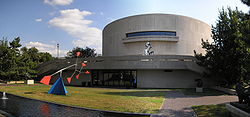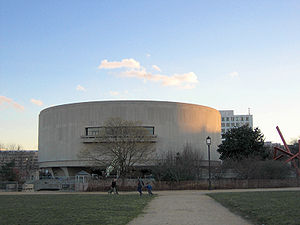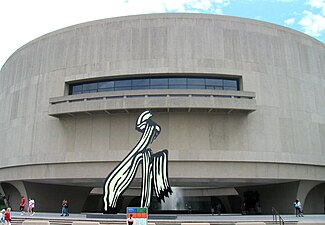
The Smithsonian Institution, or simply the Smithsonian, is a group of museums, education and research centers, the largest such complex in the world, created by the U.S. government "for the increase and diffusion of knowledge." Founded on August 10, 1846, it operates as a trust instrumentality and is not formally a part of any of the three branches of the federal government. The institution is named after its founding donor, British scientist James Smithson. It was originally organized as the United States National Museum, but that name ceased to exist administratively in 1967.

The San Francisco Museum of Modern Art (SFMOMA) is a modern and contemporary art museum and nonprofit organization located in San Francisco, California. SFMOMA was the first museum on the West Coast devoted solely to 20th-century art, and has built an internationally recognized collection with over 33,000 works of painting, sculpture, photography, architecture, design, and media arts. The collection is displayed in 170,000 square feet (16,000 m2) of exhibition space, making the museum one of the largest in the United States overall, and one of the largest in the world for modern and contemporary art.

The National Gallery of Art is an art museum in Washington, D.C., United States, located on the National Mall, between 3rd and 9th Streets, at Constitution Avenue NW. Open to the public and free of charge, the museum was privately established in 1937 for the American people by a joint resolution of the United States Congress. Andrew W. Mellon donated a substantial art collection and funds for construction. The core collection includes major works of art donated by Paul Mellon, Ailsa Mellon Bruce, Lessing J. Rosenwald, Samuel Henry Kress, Rush Harrison Kress, Peter Arrell Browne Widener, Joseph E. Widener, and Chester Dale. The Gallery's collection of paintings, drawings, prints, photographs, sculpture, medals, and decorative arts traces the development of Western art from the Middle Ages to the present, including the only painting by Leonardo da Vinci in the Americas and the largest mobile created by Alexander Calder.

The Walker Art Center is a multidisciplinary contemporary art center in the Lowry Hill neighborhood of Minneapolis, Minnesota, United States. The Walker is one of the most-visited modern and contemporary art museums in the U.S.: together with the adjacent Minneapolis Sculpture Garden and Cowles Conservatory, it has an annual attendance of around 700,000 visitors. The museum's permanent collection includes over 13,000 modern and contemporary art pieces, including books, costumes, drawings, media works, paintings, photography, prints, and sculpture.

The Smithsonian American Art Museum is a museum in Washington, D.C., part of the Smithsonian Institution. Together with its branch museum, the Renwick Gallery, SAAM holds one of the world's largest and most inclusive collections of art, from the colonial period to the present, made in the United States. More than 7,000 artists are represented in the museum's collection. Most exhibitions are held in the museum's main building, the Old Patent Office Building, while craft-focused exhibitions are shown in the Renwick Gallery.

The Denver Art Museum (DAM) is an art museum located in the Civic Center of Denver, Colorado. With an encyclopedic collection of more than 70,000 diverse works from across the centuries and world, the DAM is one of the largest art museums between the West Coast and Chicago. It is known for its collection of American Indian art, as well as The Petrie Institute of Western American Art, which oversees the museum's Western art collection. The museum's Martin Building was designed by famed Italian architect Gio Ponti in 1971.

The Portland Art Museum (PAM) is an art museum in downtown Portland, Oregon, United States. The Portland Art Museum has 240,000 square feet, with more than 112,000 square feet of gallery space. The museum’s permanent collection has over 42,000 works of art. PAM features a center for Native American art, a center for Northwest art, a center for modern and contemporary art, permanent exhibitions of Asian art, and an outdoor public sculpture garden. The Northwest Film Center is also a component of Portland Art Museum.

The National Museum of African Art is the Smithsonian Institution's African art museum, located on the National Mall of the United States capital. Its collections include 9,000 works of traditional and contemporary African art from both Sub-Saharan and North Africa, 300,000 photographs, and 50,000 library volumes. It was the first institution dedicated to African art in the United States and remains the largest collection. The Washington Post called the museum a mainstay in the international art world and the main venue for contemporary African art in the United States.

The Samuel P. Harn Museum of Art is an art museum at the University of Florida in Gainesville, Florida. It is in the UF Cultural Plaza area in the southwest part of campus.

Robert Engman was an American sculptor with works in the permanent collection of the Hirshhorn Museum, MOMA, the Whitney Museum of American Art, numerous college museums, and private collections.

Irene Rice Pereira was an American abstract artist, poet and philosopher who played a major role in the development of modernism in the United States. She is known for her work in the genres of geometric abstraction, abstract expressionism and lyrical abstraction, as well as her use of the principles of the Bauhaus school. Her paintings and writings were significantly influenced by the complex intellectual currents of the 20th century.
Melissa Chiu is an Australian museum director, curator and author, and the director of the Hirshhorn Museum and Sculpture Garden in Washington, DC.

Agricola I is a 1952 abstract sculpture by American artist David Smith. The artwork is located on the grounds at and in the collection of the Hirshhorn Museum and Sculpture Garden in Washington, D.C., United States. The word "agricola" means "farmer" in Latin. This work is the first in the Agricola series by Smith.
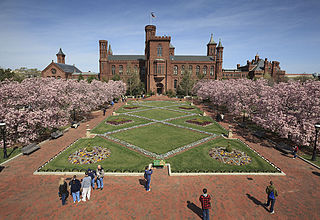
The Smithsonian Gardens, a division of the Smithsonian Institution, is responsible for the "landscapes, interiorscapes, and horticulture-related collections and exhibits", which serve as an outdoor extension of the Smithsonian's museums and learning spaces in Washington, D.C. Established in 1972 as a groundskeeping and horticulture program, Smithsonian Gardens currently manages 180 acres of gardens on the National Mall, 64,000 square feet of greenhouse production space, and the Archives of American Gardens, a research collection of over 60,000 photographs and archival records covering American landscape history from the 1870s to the present.

Linn Meyers is an American, Washington, D.C.–based artist. Her work has been exhibited in the United States and abroad. She is known for her hand-drawn lines and tracings for site-specific installations.
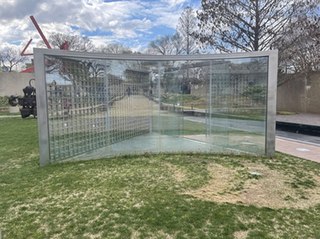
For Gordon Bunshaft is a 2006 sculpture by Dan Graham, installed at the Hirshhorn Museum and Sculpture Garden in Washington, D.C., United States. The work, which refers to American architect Gordon Bunshaft, was installed by the reflection pool of the Bunshaft-designed sculpture garden at the Hirshhorn on May 30, 2008.
Kerry Brougher is the founding director of the Academy Museum of Motion Pictures in Los Angeles, California. He has served as curator at several museums, most recently as the curator and acting director of the Hirshhorn Museum and Sculpture Garden in Washington DC.

Olga Viso is a Cuban American curator of modern and contemporary art and a museum director based at Arizona State University's Herberger Institute for Design and the Arts in Tempe, Arizona. She served as executive director of the Walker Art Center in Minneapolis, Minnesota from 2007 through 2017, and was curator of contemporary art and director of the Smithsonian Institution's Hirshhorn Museum and Sculpture Garden in Washington, DC from 1995-2007.
Will Insley was an American painter, architect, and planner of utopian urban models. As a painter of geometric abstraction, he is known for his large-area geometrical picture elements.

